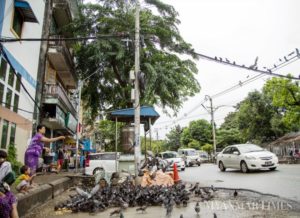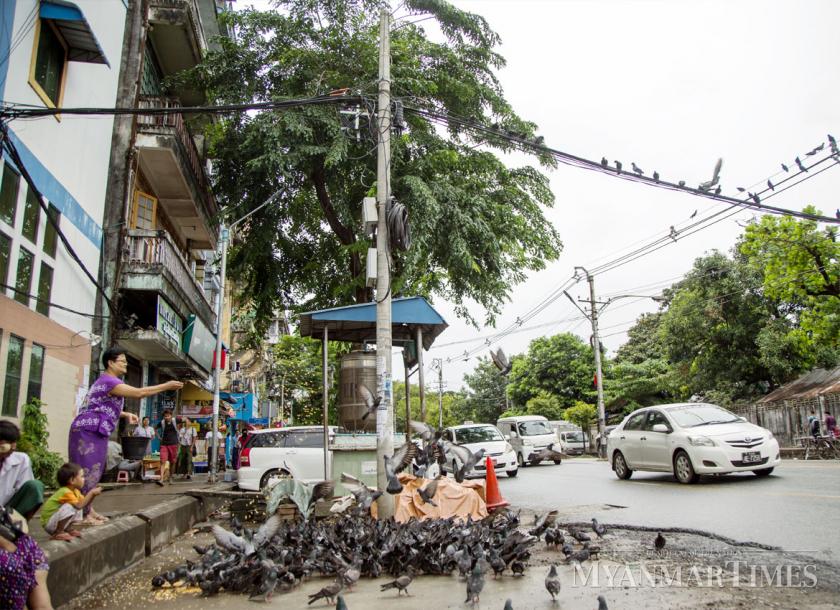
Power lines seen along Bogyoke Road in downtown Yangon
Myanmar Government readies additional supply of electricity to meet demand
22 Oct 2018
Power lines seen along Bogyoke Road in downtown Yangon
Arrangements have been made to prepare sufficient electricity to meet rising demand next year, according to the Ministry of Electricity and Energy (MOEE).
The rate of increase in electricity consumption typically rises by 15 percent per year on average. This fiscal year though, demand is expected to increase by 19pc. As such, the MOEE is aiming to raise supply to 3700 megawatts during the period, from 3400MW this year.
Soe Myint, deputy permanent secretary of electricity at the MOEE, warned though, that some projects may still be delayed, depending on the availability of funds. The ministry is expected to spend K578 billion in next year, which includes international aid.
Myanmar generates most of its energy through gas and hydropower plants. As construction of several hydropower projects is still ongoing, additional energy requirements for the fiscal year will be supplied by three gas-fired power plants, said U Khin Maung Win, managing director of the Electric Power Generation Enterprise (EPGE).
These include the 225MW combined-cycle Sembcorp Myingyan gas plant, which commenced operations this month, a second gas plant producing 90MW of energy in Myingyan as well as a 145MW plant in Belin, Kyaukse.
“We have also stored water and repaired gas towers for running existing power plantsto supply electricity for the coming summer,” said U Khin Maung Win.
Meanwhile, construction of transmission lines, substations and distribution lines to transmit the energy generated to the national grid will need to be accelerated.
However, U Khin Maung Win said more delays can be expected at this stage. “If there are financial difficulties or objections from the community in the process of constructing the supporting infrastructure such as power stations, substations and distribution lines, it will lead to delays,” he said.
Whatever the case, state funds have already been allocated for the generation of additional power. “The government wants to complete many hydropower projects and build all the power stations and lines necessary to meet electricity demand. As the MOEE enjoys the second highest priority on the budget, we will be able to expand our power generation capacity,” U Soe Myint said.
States and regions
With help from the state and World Bank, arrangements are being made to supply electricity at various townships and villages in proportionate amounts by utilising state and regional budgets, the MOEE said.
Currently, funds are being allocated towards expanding the national grid to Rakhine, Shan, Sagaing, Magwe and Mandalay. Sub-power stations will also be built across ten major cities, including Pathein,Dawei, Mawlamyine, Taunggyi and Loikaw, which, in turn, will channel electricity to more than 400 villages, in line with the National Electrification Project.
The national grid expansion project will include development of infrastructure in Thilawa as well as the 117-mile 500KV Taungoo-Kamanat transmission line project and 230KV Mawlamyine-Ye-Dawei line.
Meanwhile, upgrades are being carried out at the 118MW Thaton power station and other power stations in Hlawga, Alone, Ywama and Thaketa. The MOEE will also be building of 66KV, 33KV, 11KV, 400 KV lines and sub-stations with the aim of alleviating poverty in poorer states and regions.
Hydro power
Over the longer term, several hydropower projects are expected to come onstream. State funds will be deployed into developing only the smaller hydro power projects, while larger projects will be implemented with international help.
Currently, the Upper Yal Ywar Project, Upper Kyine Taung Project and Thahtay Hydro Project are still under construction and are expected to come onstream within the next 4-5 years, depending on the availability and frequency of funds, said U Khin Maung Win.
He added that the budget for electricity and energy is also under constant pressure as large sums are utilised to subsidise electricity for the country. This fiscal year, the government is expected to incur losses of up to K600 billion to subsidise electricity tariffs, which is up from K480 billion in 2017-18.
“We need to increase electricity prices even as we raise supply to meet demand. We are now awaiting orders from senior officials to do so,” U Khin Maung Win said.
Currently, residential prices in Myanmar are K35 per kilowatt-hour for the first 100 units, K40/kWh for the next 100 units, and K50/kWh for all units after that. With an average tariff of roughly US$0.03/kWh, these are the lowest residential prices in ASEAN, and among the lowest in the world.
Source: https://www.mmtimes.com/news/govt-readies-additional-supply-electricity-meet-demand.html



